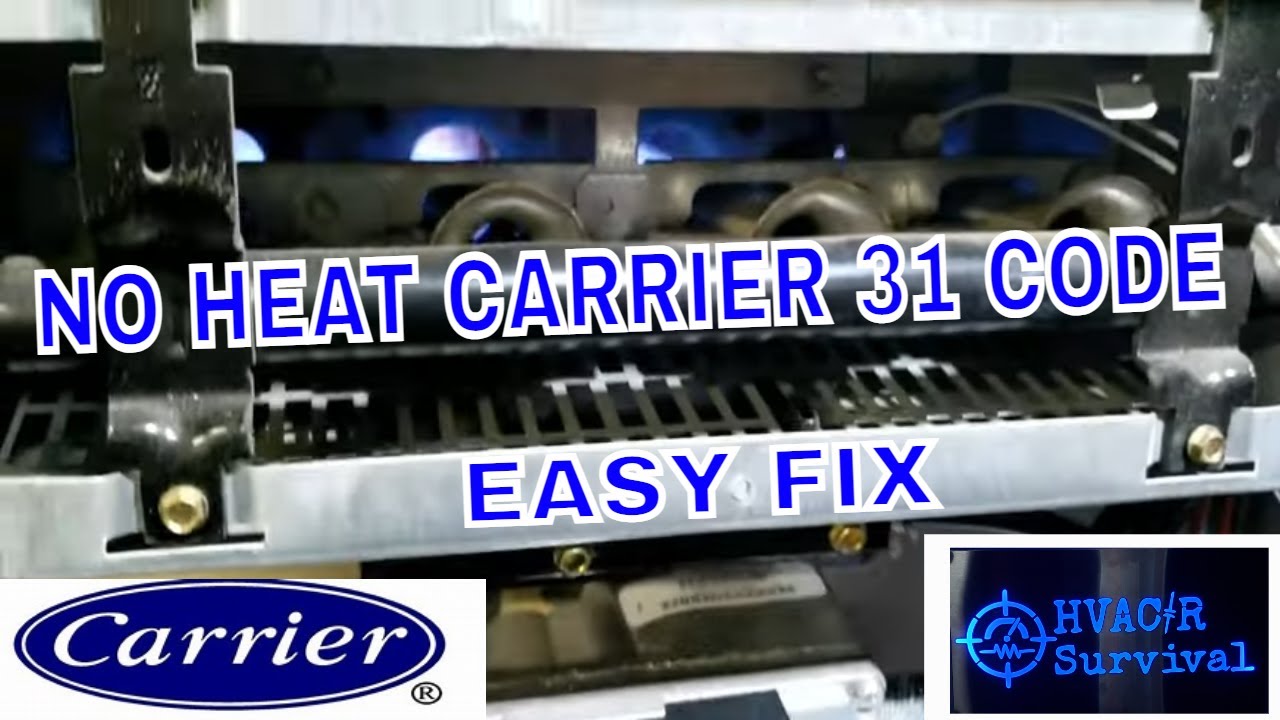The dead of winter descends, and your Carrier furnace sputters to a halt, leaving you shivering. The culprit? A blinking error code 31 on the display. Don’t panic! This comprehensive guide delves into Carrier furnace error code 31, explaining its meaning, potential causes, and DIY troubleshooting steps to get your furnace roaring back to life.

Understanding Carrier Furnace Error Code 31: Loss of Draft
Carrier furnace error code 31 indicates a “loss of draft” situation. In simpler terms, the furnace isn’t venting combustion gases and stale air out of your home efficiently. This can be caused by several factors, each requiring a specific solution.
Here’s a breakdown of why draft loss might occur:
- Clogged Flue Pipe:The flue pipe is the passage through which exhaust gases and air exit your home. A blockage within the flue pipe, caused by debris like leaves, bird nests, or even ice buildup, can significantly restrict airflow and trigger error code 31.
- Blocked Intake Pipe:Similar to a clogged flue pipe, an obstructed intake pipe that supplies fresh air for combustion can also lead to draft loss. Debris like leaves, dust, or even insect nests can impede the intake of air.
- Faulty Draft Inducer:The draft inducer is a fan that actively draws combustion gases and stale air out of the furnace and vents them outside. A malfunctioning draft inducer might not be creating enough suction, leading to draft loss.
- Venting System Issues:Issues with the overall venting system, such as disconnected sections, crushed pipes, or improper termination points, can disrupt proper airflow and trigger error code 31.
- Negative Pressure:In some cases, negative pressure within the dwelling can disrupt the furnace’s ability to vent properly. This might be caused by powerful exhaust fans in other areas of the house, like a bathroom vent fan running simultaneously with the furnace.
Before You Begin: Safety First!
Before attempting any troubleshooting steps, always ensure your safety:
- Turn Off the Furnace:Locate the main power switch or breaker that controls your furnace and turn it off. This prevents accidental ignition while troubleshooting.
- Let the Furnace Cool Down:Allow the furnace ample time to cool down completely before touching any internal components.
- Consult a Professional:If you’re unsure about any step, especially those involving electrical components or gas lines, always err on the side of caution and consult a qualified HVAC technician.
DIY Troubleshooting Steps for Carrier Furnace Error Code 31
- Visual Inspection:
- Check the Flue Pipe:Carefully examine the exterior of the flue pipe for any visible blockages, debris, or ice buildup.
- Inspect the Intake Pipe:Locate the intake pipe and visually inspect it for obstructions like leaves, dust, or insect nests.
- Review the Venting System:Visually inspect the entire length of the venting system, both indoors and outdoors, for any loose connections, crushed pipes, or improper termination points.
- Cleaning (if applicable):
- Cleaning the Flue Pipe:If you suspect a blockage in the flue pipe, professional cleaning might be necessary to ensure safe and efficient removal of debris.
- Cleaning the Intake Pipe:If the intake pipe appears blocked by leaves, dust, or debris, you might be able to carefully remove the obstruction using a vacuum cleaner. However, exercise caution and avoid damaging the pipe.
- Resetting the Furnace:
Once you’ve completed the visual inspection and any potential cleaning (if safe and applicable), attempt to reset the furnace by turning it off at the breaker for 30 seconds, then turning it back on. In some cases, a simple reset can clear the error code.
- Consulting a Professional:
If the visual inspection doesn’t reveal any obvious blockages, cleaning doesn’t resolve the issue, or you’re unsure about any step, it’s crucial to consult a qualified HVAC technician. They can diagnose the root cause of the draft loss, whether it’s a faulty draft inducer, venting system issues, or negative pressure, and perform the necessary repairs to ensure your furnace operates safely and efficiently.
Additional Tips:
- Schedule Regular Maintenance:Regular maintenance by a qualified HVAC technician can help prevent future furnace problems and ensure optimal performance.
- Invest in a Carbon Monoxide Detector:A properly functioning carbon monoxide detector is essential for your safety. Ensure your CO detector is operational and replace the batteries regularly.
Conclusion
Carrier furnace error code 31 can bring a temporary chill to your home, but by understanding its meaning, potential causes, and following these troubleshooting steps, you can potentially get your furnace back up and running. Remember, safety is paramount. If you’re uncomfortable or unsure about any troubleshooting step, especially those involving electrical components or gas lines, don’t hesitate to call a qualified HVAC technician. They possess the expertise and tools to diagnose and repair the problem efficiently, ensuring your furnace operates safely and restores warmth to your home.
Sources:
- Carrier Website – Troubleshooting Guides (consult your specific furnace model for detailed instructions).
- North American Technician Excellence (NATE) – Consumer Resources.
- The Spruce – How to Troubleshoot a Carrier Furnace Error Code 31: (This website provides a general overview of troubleshooting steps)
- Federal Trade Commission (FTC) – Choosing a Home Service Provider: (This resource offers guidance on selecting a qualified HVAC technician)